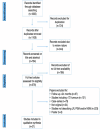Lights and shadows on local recurrence after renal surgery: when, why and how to manage
- PMID: 40777103
- PMCID: PMC12327261
- DOI: 10.3389/fruro.2024.1419418
Lights and shadows on local recurrence after renal surgery: when, why and how to manage
Abstract
Introduction: This review aims to analyze the existing literature on local recurrence (LR) in patients undergoing partial nephrectomy (PN) for renal cell carcinoma, identifying relative risk factors, and exploring optimal clinical management strategies.
Methods: A comprehensive literature search was conducted across bibliographic databases, primarily focusing on LR rates. Secondary outcomes included evaluation of positive surgical margins (PSM), nephrometry scores, pathological stage (T and grading), perioperative outcomes, time-to-LR, overall survival, and cancer-specific survival.
Results: Due to the heterogeneity, a narrative synthesis was performed. LR rates after PN varied in the literature; with PSM emerging as a significant risk factor. Other LR risk factors included pathological stage, nephrometry scores, and histological variants. However, evidence regarding optimal LR management in the absence of precise indications was lacking.
Conclusion: LR represents a significant clinical challenge; requiring multidisciplinary assessment and shared decision-making with patients. Given well-established risk factors, clinicians must tailor management strategies to optimize patient outcomes.
Keywords: local recurrence; partial nephrectomy; positive surgical margin; prognostic factor; renal cell carcinoma; review.
Copyright © 2024 Di Gianfrancesco, Crestani, Amodeo, Corsi, De Marchi, Miglioranza, Lista, Vitelli, Simonetti, Busetto, Falagario, Maggi, Marino, Genovese, Falabella and Porreca.
Conflict of interest statement
The authors declare that the research was conducted in the absence of any commercial or financial relationships that could be construed as a potential conflict of interest.
References
Publication types
LinkOut - more resources
Full Text Sources
Miscellaneous

